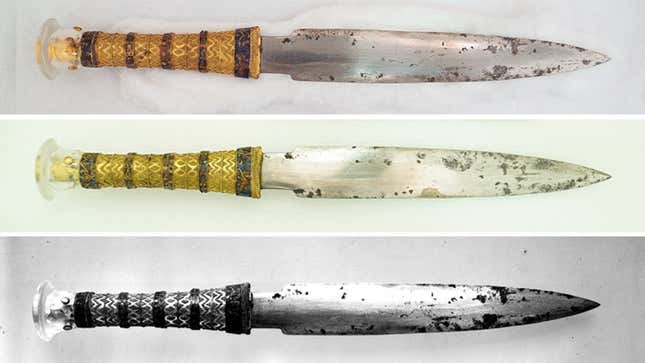
A team of researchers recently X-ray scanned an iron dagger found in the tomb of Tutankhamun to figure out how the object, the metal of which came from a meteorite, was made. They suspect the dagger was created through low-temperature forging—but they don’t think it was crafted in Egypt.
When archaeologists entered Tutankhamun’s burial chamber in the Valley of the Kings in the 1920s, they found a foot-long dagger among the splendor entombed with the pharaoh. Its blade was made of iron, a perplexing discovery considering the Iron Age didn’t kick off until a century after Tut’s death.
Iron objects that precede widespread knowledge of iron metallurgy have led researchers to believe that older items come from meteoritic iron—chunks of the metal that fell from space and were then forged on Earth.
The stuff was highly valued in Egypt and beyond. A meteoritic dagger found in Turkey dates to the Early Bronze Age, 1,000 years before Tutankhamun was born. Besides the dagger, Tutankhamun was entombed with an iron headrest and an iron bracelet.
A 2016 study affirmed the likely meteoritic origin of the pharaoh’s iron, but questions remained about the kind of meteorite it came from and how it was forged. That’s where the new study comes in, published this month in Meteoritics & Planetary Science.
“To understand the manufacture and origin of the dagger, we conducted on-site non-contact, non-destructive two-dimensional chemical analysis for the dagger,” study co-author Tomoko Arai, a researcher at the Chiba Institute of Technology in Japan, wrote in an email to Gizmodo.
The researchers mapped the elemental structure of the blade by shining X-rays onto it, revealing concentrations of iron, nickel, manganese, and cobalt. In the blackened spots on the blade, they found sulfur, chlorine, calcium, and zinc. But just as interesting as the elements present was their distribution.

“We noticed a cross-hatched texture present in places for the both sides [of the dagger], suggesting Widmanstätten structure, typical of [an] octahedrite iron meteorite,” Arai said. “That was our WOW moment.”
The Widmanstätten pattern (named for an Austrian mineralogist) is a remarkable effect present in some metallic meteorites that’s caused by how nickel is distributed throughout the objects. The pattern’s presence in Tutankhamun’s weapon indicates that the dagger was made from an octahedrite, the largest group of iron meteorites.
To verify what they were seeing in the elemental analysis, the team compared the pattern on Tut’s dagger with the pattern on the Japanese meteorite Shirahagi. Shirahagi was the source of the iron in some Japanese swords acquired by the Taisho Emperor. Octahedrites, apparently, are a favorite of monarchies everywhere.
The pattern’s presence in the ancient Egyptian dagger also hints at how it was made. The team wrote in their paper that the Widmanstätten pattern would disappear if the iron were heated to a very high temperature.
“We also found small black patches in places on the surface,” Arai said. “We thought they were rust at first. But it turns out that they were iron sulfide, which generally occur as inclusions in octahedrite iron meteorites.”
Arai said that the presence of iron sulfide, as well as the subtle Widmanstätten pattern, indicates the dagger was forged with relatively low heat—less than 950° Celsius (1,742° Fahrenheit.)
Though the chemical analysis didn’t offer clues to the dagger’s origins, the team turned to a series of 3,400-year-old tablets known as the Amarna Letters, which document diplomatic activities in ancient Egypt in the mid-14th century BCE. The letters mention an iron dagger in a gold sheath—presumably not a common accessory back then—that was given to Amenhotep III, Tutankhamun’s grandfather, by the king of Mitanni, a region of Anatolia, when the pharaoh married his daughter.
So perhaps Tutankhamun’s space dagger was a family heirloom, received from abroad. The researcher’s elemental analysis also indicated that gemstones in the dagger’s hilt were attached with lime plaster, which was used commonly in Mitanni but didn’t catch on in Egypt until later.
Arai said that future studies will be helpful to further confirm this assessment of the blade. Whether an epic wedding present or not, this dagger’s story didn’t end with its royal burial.
More: 3-Foot-Long Sword Discovered Off Israel’s Coast Dates Back to the Crusades